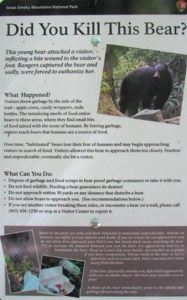by Sara Haxby
Bears and Food Storage on the A.T.
Bears are found along the entire length of the Appalachian Trail. In any location along the Trail, bears may pursue human food when easy access is available. Storing your food properly is critical in order to protect your food, bears, and you. Visitors to Great Smoky Mountains National Park may recall this sign:
ATC maintains a Bear Incident Report, based on incidents submitted by visitors to the Trail. Incidents are continuing to rise steadily, and most (67%) involved food hangs and storage that the bear “defeated.” Read the 2018 Bear Incidents on the Trail Summary. What now?
A presentation on “Bear and Human Interactions” at the July 2019 A.T. Federal Managers Meeting resulted in a request that ATC and its partners develop a draft Trailwide food storage regulation.
Because of ongoing human-bear conflicts, all NPS units and USFS districts traversed by the A.T. have food storage direction and/or regulations, but it varies.
Despite the current regulations, there have been numerous human-bear conflicts on the A.T. in the last few years resulting in closures of campsites, shelters and A.T. sections, large quantities of food taken by bears, damaged food containers, tents and packs, injured humans, and euthanized bears.
Starting this fall ATC is getting the ball rolling on the request to evaluate the potential for trailwide food storage regulation by gathering input. Clubs are reviewing a brief at fall 2019 Regional Partnership Committee meetings, discussing the efficacy of hanging food, and weighing considerations for a trailwide approach.
The goals of this effort are to protect Trail visitors, protect wildlife, and add minimal infrastructure at overnight sites which come with additional maintenance.
People with interest in this topic are encouraged to connect with their local A.T. maintenance club, and to talk to the Regional Partnership Committee representative from that club about this topic. Clubs and their representatives are Trail management partners who contribute to the management and maintenance of the A.T. and contribute to policy and guidance recommendations for the management and protection of the Trail.
